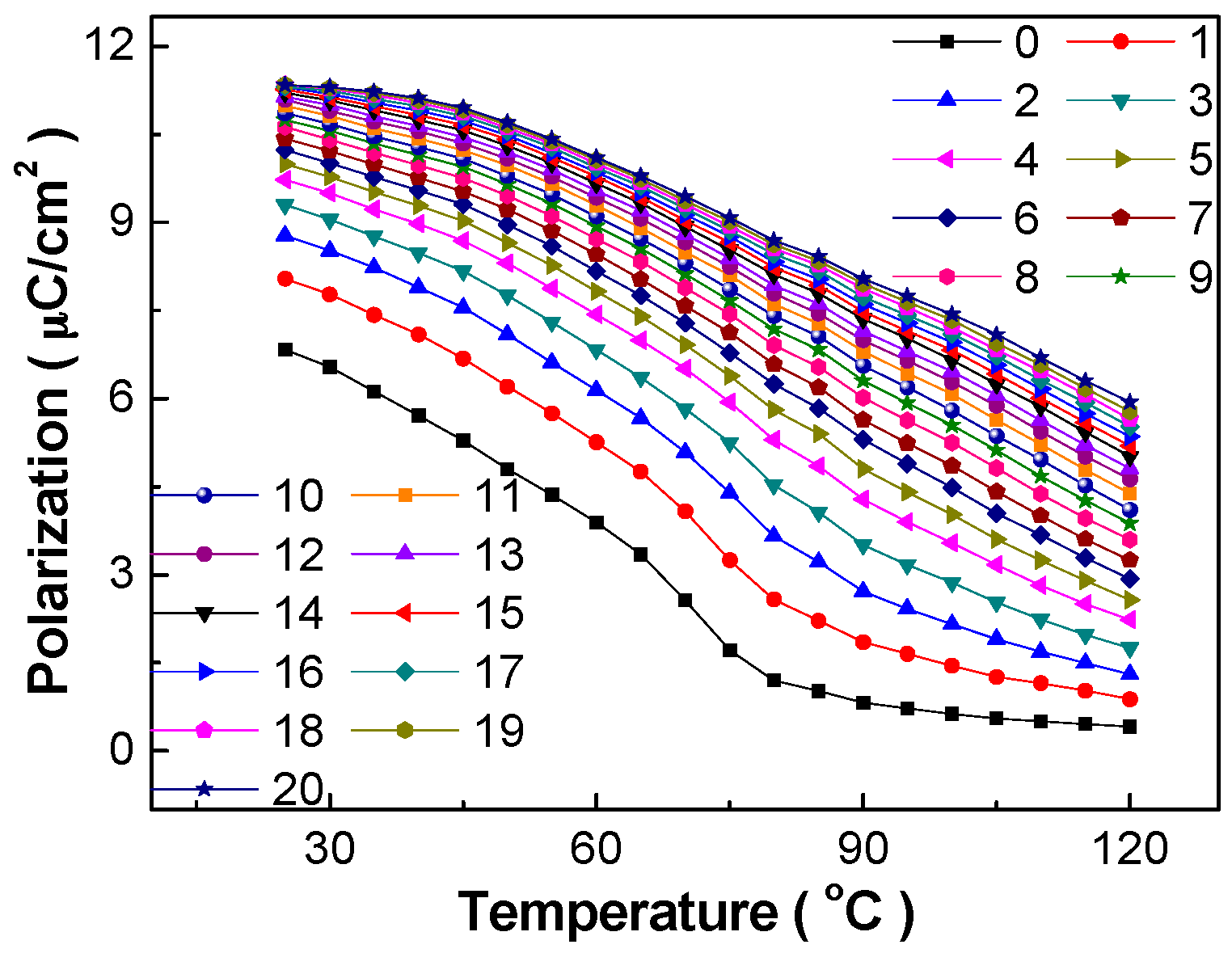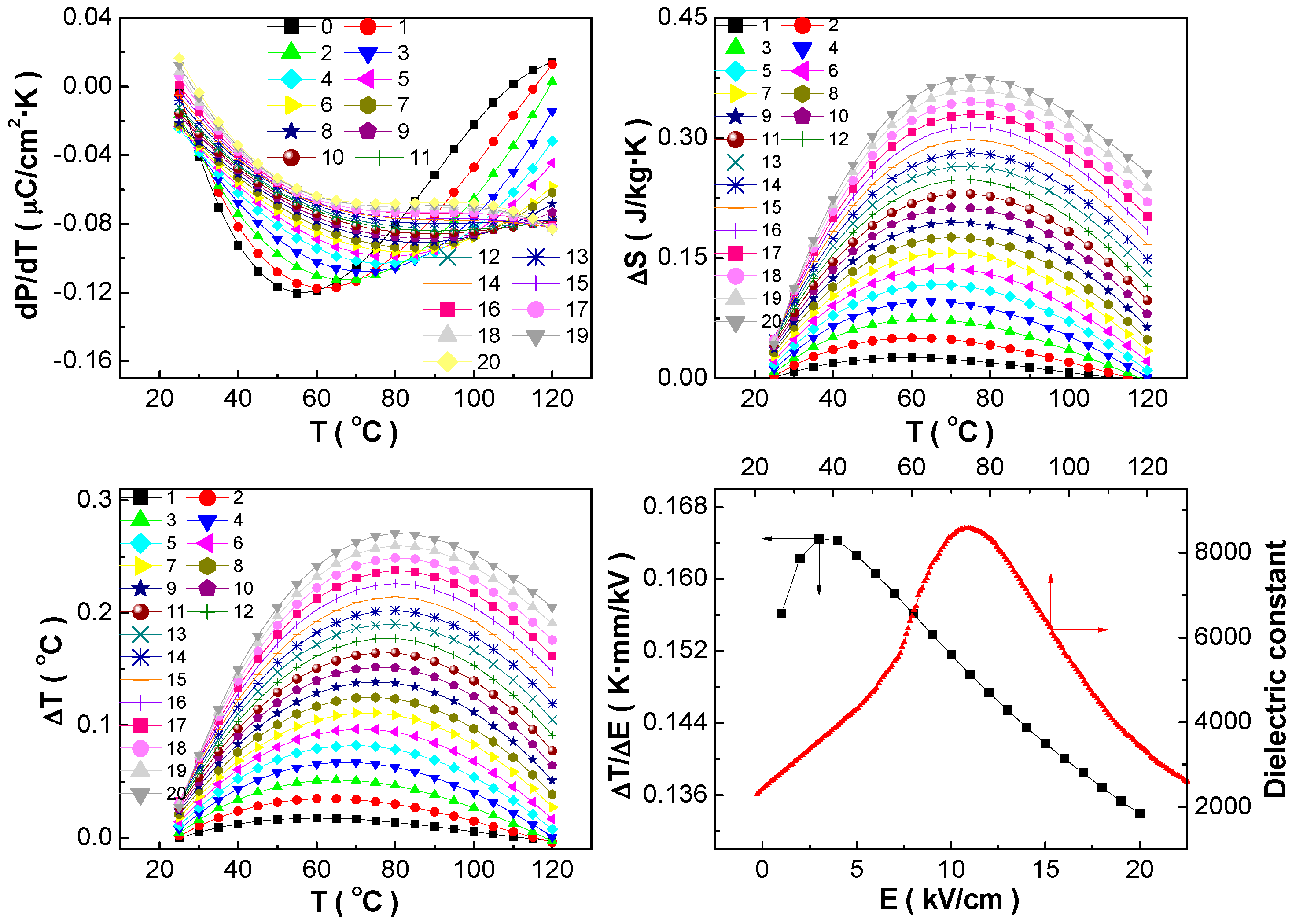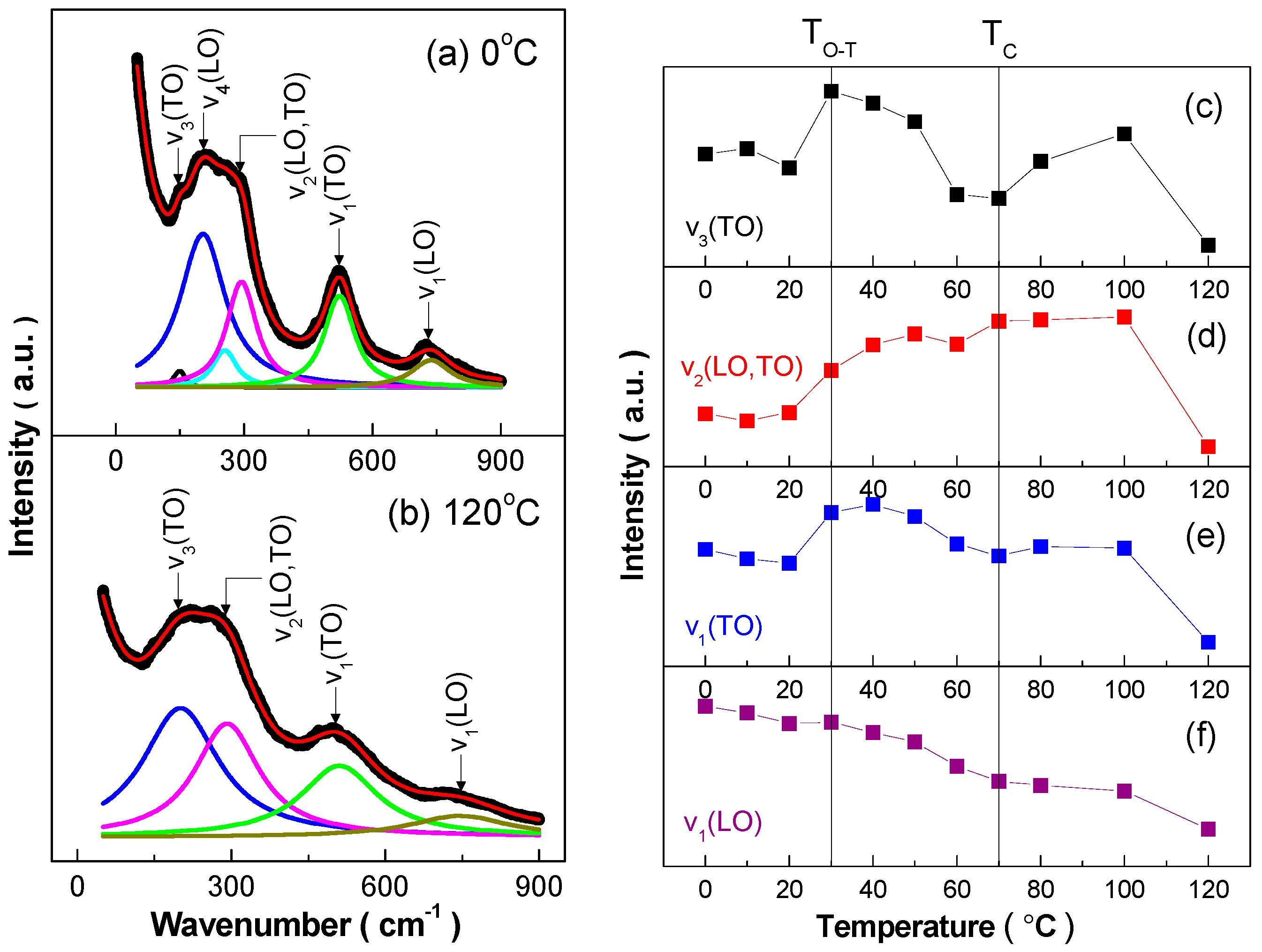Large Electrocaloric Effect in Lead-Free (Ba0.85Ca0.15)(Zr0.1Ti0.9)O3 Ceramics Prepared via Citrate Route
Abstract
1. Introduction
2. Materials and Methods
3. Results and Discussion
4. Conclusions
Acknowledgments
Author Contributions
Conflicts of Interest
References
- Mischenko, A.S.; Zhang, Q.; Scott, J.F.; Whatmore, R.W.; Mathur, N.D. Giant electrocaloric effect in thin-film PbZr0.95Ti0.05O3. Science 2006, 311, 1270–1271. [Google Scholar] [CrossRef] [PubMed]
- Lu, S.-G.; Zhang, Q. Electrocaloric materials for solid-state refrigeration. Adv. Mater. 2009, 21, 1983–1987. [Google Scholar] [CrossRef]
- Valant, M. Electrocaloric materials for future solid-state refrigeration technologies. Prog. Mater. Sci. 2012, 57, 980–1009. [Google Scholar] [CrossRef]
- Moya, X.; Kar-Narayan, S.; Mathur, N.D. Caloric materials near ferroic phase transitions. Nat. Mater. 2014, 13, 439–450. [Google Scholar] [CrossRef] [PubMed]
- Park, S.E.; Hackenberger, W. High performance single crystal piezoelectrics: Applications and issues. Curr. Opin. Solid State Mater. Sci. 2002, 6, 11–18. [Google Scholar] [CrossRef]
- Fu, H.; Cohen, R.E. Polarization rotation mechanism for ultrahigh electromechanical response in single-crystal piezoelectrics. Nature 2000, 403, 281–283. [Google Scholar] [PubMed]
- Keeble, D.S.; Benabdallah, F.; Thomas, P.A.; Maglione, M.; Kreisel, J. Revised structural phase diagram of (Ba0.7Ca0.3TiO3)-(BaZr0.2Ti0.8O3). Appl. Phys. Lett. 2013, 102, 092903. [Google Scholar] [CrossRef]
- Kutnjak, Z.; Petzelt, J.; Blinc, R. The giant electromechanical response in ferroelectric relaxors as a critical phenomenon. Nature 2006, 441, 956–959. [Google Scholar] [CrossRef] [PubMed]
- Lu, S.G.; Rozic, B.; Zhang, Q.M.; Kutnjak, Z.; Pirc, R. Electrocaloric effect in ferroelectric polymers. Appl. Phys. A 2012, 107, 559–566. [Google Scholar] [CrossRef]
- Moya, X.; Stern-Taulats, E.; Crossley, S.; González-Alonso, D.; Kar-Narayan, S.; Planes, A.; Mañosa, L.; Mathur, N.D. Giant electrocaloric strength in single-crystal BaTiO3. Adv. Mater. 2013, 25, 1360–1365. [Google Scholar] [CrossRef] [PubMed]
- Kriaa, I.; Maalej, A.; Khemakhem, H. Electrocaloric Study Effect in the Relaxor Ferroelectric Ceramic 0.9(0.75PMN-0.25PT)-0.1PS. J. Electron. Mater. 2017, 46, 2529–2532. [Google Scholar] [CrossRef]
- Li, F.; Chen, G.; Liu, X.; Zhai, J.; Shen, B.; Li, S.; Li, P.; Yang, K.; Zeng, H.; Yan, H. Type-I pseudo-first-order phase transition induced electrocaloric effect in lead-free Bi0.5Na0.5TiO3-0.06BaTiO3 ceramics. Appl. Phys. Lett. 2017, 110, 182904. [Google Scholar] [CrossRef]
- Zhao, Y.; Hao, X.; Zhang, Q. A giant electrocaloric effect of a Pb0.97La0.02(Zr0.75Sn0.18Ti0.07)O3 antiferroelectric thick film at room temperature. J. Mater. Chem. C 2015, 3, 1694–1699. [Google Scholar] [CrossRef]
- Jaffe, B.; Roth, R.S.; Marzullo, S. Piezoelectric properties of lead zirconate-lead titanate solid-solution ceramics. Appl. Phys. 1954, 25, 809–810. [Google Scholar] [CrossRef]
- Fang, B.; Qian, K.; Chen, Z.; Yuan, N.; Ding, J.; Zhao, X.; Xu, H.; Luo, H. Large strain and pyroelectric properties of Pb(Mg1/3Nb2/3)O3-PbTiO3 ceramics prepared by partial oxalate route. Funct. Mater. Lett. 2014, 7, 1450059. [Google Scholar] [CrossRef]
- Zhu, R.; Ji, W.; Fang, B.; Wu, D.; Chen, Z.; Ding, J.; Zhao, X.; Luo, H. Ferroelectric phase transition and electrical conduction mechanisms in high Curie-temperature PMN-PHT piezoelectric ceramics. Ceram. Int. 2017, 43, 6417–6424. [Google Scholar] [CrossRef]
- Liu, W.; Ren, X. Large piezoelectric effect in Pb-free ceramics. Phys. Rev. Lett. 2009, 103, 257602. [Google Scholar] [CrossRef] [PubMed]
- Bao, H.; Zhou, C.; Xue, D.; Gao, J.; Ren, X. A modified lead-free piezoelectric BZT-xBCT system with higher TC. J. Phys. D Appl. Phys. 2010, 43, 465401. [Google Scholar] [CrossRef]
- Fang, B.J.; Wang, W.W.; Ding, J.N.; Zhao, X.Y.; Xu, H.Q.; Luo, H.S. Preparation and electrical properties of pseudoternary BaTiO3-CaTiO3-BaZrO3 lead free piezoelectric ceramics. Adv. Appl. Ceram. 2013, 112, 257–262. [Google Scholar] [CrossRef]
- Zhang, L.; Zhang, M.; Wang, L.; Zhou, C.; Zhang, Z.; Yao, Y.; Zhang, L.; Xue, D.; Lou, X.; Ren, X. Phase transitions and the piezoelectricity around morphotropic phase boundary in Ba(Zr0.2Ti0.8)O3-x(Ba0.7Ca0.3)TiO3 lead-free solid solution. Appl. Phys. Lett. 2014, 105, 162908. [Google Scholar] [CrossRef]
- Gao, J.; Hu, X.; Zhang, L.; Li, F.; Zhang, L.; Wang, Y.; Hao, Y.; Zhong, L.; Ren, X. Major contributor to the large piezoelectric response in (1-x)Ba(Zr0.2Ti0.8)O3-x(Ba0.7Ca0.3)TiO3 ceramics: Domain wall motion. Appl. Phys. Lett. 2014, 104, 252909. [Google Scholar] [CrossRef]
- Qian, K.; Fang, B.; Du, Q.; Ding, J.; Zhao, X.; Luo, H. Phase development and electrical properties of Pb(Mg1/3Nb2/3)O3-PbTiO3 ceramics prepared by partial oxalate route. Phys. Status Solid A 2013, 210, 1149–1156. [Google Scholar] [CrossRef]
- Villafuerte-Castrejón, M.; Morán, E.; Reyes-Montero, A.; Vivar-Ocampo, R.; Peña-Jiménez, J.-A.; Rea-López, S.-O.; Pardo, L. Towards lead-free piezoceramics: Facing a synthesis challenge. Materials 2016, 9, 21. [Google Scholar] [CrossRef] [PubMed]
- Randall, C.A.; Kim, N.; Kucera, J.-P.; Cao, W.; Shrout, T.R. Intrinsic and extrinsic size effects in fine grained morphotropic phase boundary lead zirconate titanate ceramics. J. Am. Ceram. Soc. 1998, 81, 677–688. [Google Scholar] [CrossRef]
- Su, Y.-L.; Chen, X.-M.; Yu, Z.-D.; Lian, H.-L.; Zheng, D.-D.; Peng, J.-H. Comparative study on microstructure and electrical properties of (K0.5Na0.5)NbO3 lead-free ceramics prepared via two different sintering methods. J. Mater. Sci. 2017, 52, 2934–2943. [Google Scholar] [CrossRef]
- Liu, X.; Zhu, M.; Chen, Z.; Fang, B.; Ding, J.; Zhao, X.; Xu, H.; Luo, H. Structure and electrical properties of Li-doped BaTiO3-CaTiO3-BaZrO3 lead-free ceramics prepared by citrate method. J. Alloys Compd. 2014, 613, 219–225. [Google Scholar] [CrossRef]
- Liu, X.; Chen, Z.; Wu, D.; Fang, B.; Ding, J.; Zhao, X.; Xu, H.; Luo, H. Enhancing pyroelectric properties of Li-doped (Ba0.85Ca0.15)(Zr0.1Ti0.9)O3 lead-free ceramics by optimizing calcination temperature. Jpn. J. Appl. Phys. 2015, 54, 071501. [Google Scholar] [CrossRef]
- Fang, B.; Liu, X.; Li, X.; Ding, J.; Zhao, X.; Luo, H. Temperature-dependent Raman spectra and electrical properties of 0.69Pb(Mg1/3Nb2/3)O3-0.31PbTiO3 single crystals. Appl. Phys. A 2016, 122, 811. [Google Scholar] [CrossRef]
- Uchino, K.; Nomura, S. Critical exponents of the dielectric constants in diffused-phase-transition crystals. Ferroelectr. Lett. 1982, 44, 55–61. [Google Scholar] [CrossRef]
- Liu, C.; Liu, X.; Wang, D.; Chen, Z.; Fang, B.; Ding, J.; Zhao, X.; Xu, H.; Luo, H. Improving piezoelectric property of BaTiO3-CaTiO3-BaZrO3 lead-free ceramics by doping. Ceram. Int. 2014, 40, 9881–9887. [Google Scholar] [CrossRef]
- Ramesh, G.; Rao, M.S.R.; Sivasubramanian, V.; Subramanian, V. Electrocaloric effect in (1-x)PIN-xPT relaxor ferroelectrics. J. Alloys Compd. 2016, 663, 444–448. [Google Scholar] [CrossRef]
- Sanlialp, M.; Shvartsman, V.V.; Acosta, M.; Lupascu, D.C. Electrocaloric effect in Ba(Zr,Ti)O3-(Ba,Ca)TiO3 ceramics measured directly. J. Am. Ceram. Soc. 2016, 99, 4022–4030. [Google Scholar] [CrossRef]
- Pezzotti, G. Raman spectroscopy of piezoelectrics. J. Appl. Phys. 2013, 113, 211301. [Google Scholar] [CrossRef]
- Zhu, R.; Yang, L.; Fang, B.; Ding, J.; Zhao, X.; Luo, H. Ferroelectric phase transitions of the 0.32PIN-0.345PMN-0.335PT single crystals studied by temperature-dependent Raman spectroscopy, dielectric and ferroelectric performance. Phase Transit. 2017, 90, 500–508. [Google Scholar] [CrossRef]
- Perry, C.H.; Hall, D.B. Temperature dependence of the Raman spectrum of BaTiO3. Phys. Rev. B 1965, 15, 700–702. [Google Scholar] [CrossRef]
- Liu, Y.; Scott, J.F.; Dkhil, B. Some strategies for improving caloric responses with ferroelectrics. APL Mater. 2016, 4, 064109. [Google Scholar] [CrossRef]





© 2017 by the authors. Licensee MDPI, Basel, Switzerland. This article is an open access article distributed under the terms and conditions of the Creative Commons Attribution (CC BY) license (http://creativecommons.org/licenses/by/4.0/).
Share and Cite
Shi, J.; Zhu, R.; Liu, X.; Fang, B.; Yuan, N.; Ding, J.; Luo, H. Large Electrocaloric Effect in Lead-Free (Ba0.85Ca0.15)(Zr0.1Ti0.9)O3 Ceramics Prepared via Citrate Route. Materials 2017, 10, 1093. https://doi.org/10.3390/ma10091093
Shi J, Zhu R, Liu X, Fang B, Yuan N, Ding J, Luo H. Large Electrocaloric Effect in Lead-Free (Ba0.85Ca0.15)(Zr0.1Ti0.9)O3 Ceramics Prepared via Citrate Route. Materials. 2017; 10(9):1093. https://doi.org/10.3390/ma10091093
Chicago/Turabian StyleShi, Jing, Rongfeng Zhu, Xing Liu, Bijun Fang, Ningyi Yuan, Jianning Ding, and Haosu Luo. 2017. "Large Electrocaloric Effect in Lead-Free (Ba0.85Ca0.15)(Zr0.1Ti0.9)O3 Ceramics Prepared via Citrate Route" Materials 10, no. 9: 1093. https://doi.org/10.3390/ma10091093
APA StyleShi, J., Zhu, R., Liu, X., Fang, B., Yuan, N., Ding, J., & Luo, H. (2017). Large Electrocaloric Effect in Lead-Free (Ba0.85Ca0.15)(Zr0.1Ti0.9)O3 Ceramics Prepared via Citrate Route. Materials, 10(9), 1093. https://doi.org/10.3390/ma10091093





